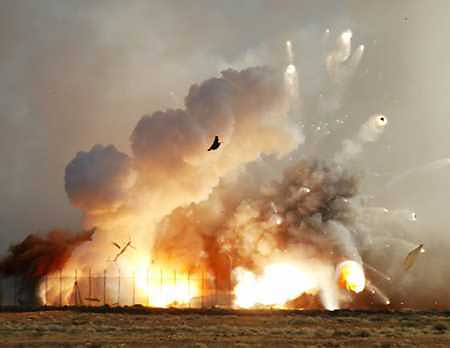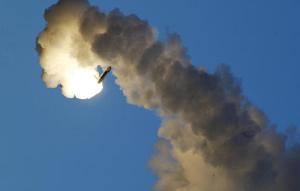
|
|
|
What's IotD? The interesting, amazing, or mind-boggling images of our days. |
|
IotD Stuff |
|
Permalink Latest Image |
|
|
|
Some folks who have noticed IotD
Neatorama |
|
Common image haunts
Astro Pic of the Day |
|
Advertising |
7/10/2002: New Japanese supersonic jet

This is only an artist's impression, but tomorrow they are going to be launching something like this in the Australian desert, if conditions are right (wind might prevent it). I guess tomorrow's launch is a proof-of-concept because they are only going to launch a 36-foot-long model of it, but...
Engineered by the Japanese, it's a passenger jet. It's called the "X1", after the jet that Chuck Yeager test-piloted past the speed of sound. They hope it will fly faster than the Concorde, hold three times as many passengers, travel twice the Concorde's range, and be roughly half as loud. They think it will pollute less than conventional jets, and hijackers will be automatically ejected through a special trapdoor in the tail.
No just kidding on that last bit.
The noise level is important, because the Concorde is limited to where it can take off and land because of its supersonic boom. I think the idea here is to launch the vehicle well into space, and allow it to get help from gravity, speedily flying down to where it will land.
It's all the result of applying new materials science and computer modeling of flight. But even in the best-case scenario, they don't expect an actual passenger jet to come out of this approach for another ten years at least.
dave Wednesday Jul 10 10:15 AM
Just wanted to be an asshole and point out that the Concorde could actually take off and land from anywhere, but it's not to get over Mach 1 while over land. Because of the sonic boom, of course.
It just means that the Concorde is only useful for flying over big stretches of water. Flying one across the US would be silly because it can't go much faster than a normal jet (say, 767, which flies at about .79 Mach if I remember correctly). So that's why it's only used when making overseas trips.
BrianR Wednesday Jul 10 11:41 AM
It sounds (and kinda looks) like an ICBM to me.
Brian the Paranoid
elSicomoro Wednesday Jul 10 11:49 AM
Isn't the Concorde useless from a practical standpoint as it is, hence why there are only 5 of them? (Other than if you want to get from Paris to JFK in under an hour and have a ton of cash.)
I'm all for the advancement of rapid flights, but how long before Joe Schmoe will be on this bad boy? 30 years?
MaggieL Wednesday Jul 10 12:06 PM
The aircraft looks a bit like the very early concept drawings for the XB-70 and space shuttle. It's what's called a "boost glider"; and it's not a jet at all. The rocket booster gets it up high and fast, and then the glider detaches.
<blockquote><i> The model will piggy-back on a 10 meter (almost 33 foot) rocket at 2450 kmh (1,522 mph), detaching from the booster 18 km (11 miles) above the earth and gliding back down at over twice the speed of sound. The test will take a total of 15 minutes.... The scientists, sponsored by Japan's government-funded National Aerospace Laboratory (NAL), plan to put the engine-less 11.5 meter (almost 38-foot) long scale model through its paces in a rocket-propelled test in Australia's desert on Thursday.
</i></blockquote>http://asia.cnn.com/2002/WORLD/asiap...eut/index.html
What they're trying to do is produce a supersonic airframe with minimal moise. That would be nice....and would solve a lot of the current operational problems that the Concorde has.
I don't think you''ll see any passenger applications of this technology within the next 15 years.
russotto Wednesday Jul 10 04:06 PM
If you can get the range to cross the Pacific, you probably CAN get some nice passenger applications. 1 hour as opposed to 6 is nice (though the ride on the Concord sucks, I'm told). 3 as opposed to 18 would be WONDERFUL. And there's plenty of wealthy people who want to cross the pacific.
elSicomoro Wednesday Jul 10 04:30 PM
Incidentally, to fly round trip on the Concorde from JFK in NYC to DeGaulle in Paris (Air France), one month advanced booking:
$10,470.93
Time of flight each way: Just under 4 hrs., normally 7-8 hrs.
tw Thursday Jul 11 05:55 PM
A problem confronting these airframe designers is that by flying higher than Concord, they enter the ozone layer. There are so few Concords or other planes flying at or above those altitudes meaning that ozone depletition is not a problem. However if used for extensive commercial traffic, then those planes must use ozone friendly fuels. Last I read, this problem had not been solved AND was still debated as to whether it would be a problem. Once Reagan's hypersonic airplane became irrelevant, a worry over ozone depletion disappeared with it.
Joe Thursday Jul 11 07:26 PM
uh-oh
You know, once the Japanese have enough of these planes, they'll be able to finally take out the US once and for all.
sleemanj Thursday Jul 11 07:51 PM
|
Originally posted by MaggieL The aircraft looks a bit like the very early concept drawings for the XB-70 and space shuttle. It's what's called a "boost glider"; and it's not a jet at all. The rocket booster gets it up high and fast, and then the glider detaches. |
Current passenger jets get turned around from arrival to departure in a matter of minutes, seems like this thing could take weeks unless they have a large quantity of boosters always in rotation.
MaggieL Thursday Jul 11 10:21 PM
|
Originally posted by sleemanj It seems to me this would be a very expensive way to fly... |
US companies are doing the heavy lifting in that research right now....to the extent that they're still getting government money.
tokenidiot Sunday Jul 14 11:08 AM
http://www.cnn.com/2002/WORLD/asiapc...eut/index.html
Undertoad Sunday Jul 14 11:12 AM
Yup.


Spectacular failure. Well I guess this is why you start with an unmanned jet and kick off your experiments in the outback.
MaggieL Sunday Jul 14 03:03 PM
|
Originally posted by Undertoad Spectacular failure. Well I guess this is why you start with an unmanned jet and kick off your experiments in the outback. |
I'm wondering if these recent failures aren't in part due to the fact that the rocket engineers of the 1960's and 1970's are all retiring, and there's few or no expereienced rocket engineers coming up behind them.
But, I say again, it's not an unmanned jet...it's really a glider. The aircraft model being tested has <b>no</b> engines of any kind.
blase Sunday Jul 14 03:52 PM
A video of it crashing, along with one very spooked kangaroo
http://news.bbc.co.uk/media/video/38...arrison_vi.ram
|
Your reply here?
The Cellar Image of the Day is just a section of a larger web community: a bunch of interesting folks talking about everything. Add your two cents to IotD by joining the Cellar. |